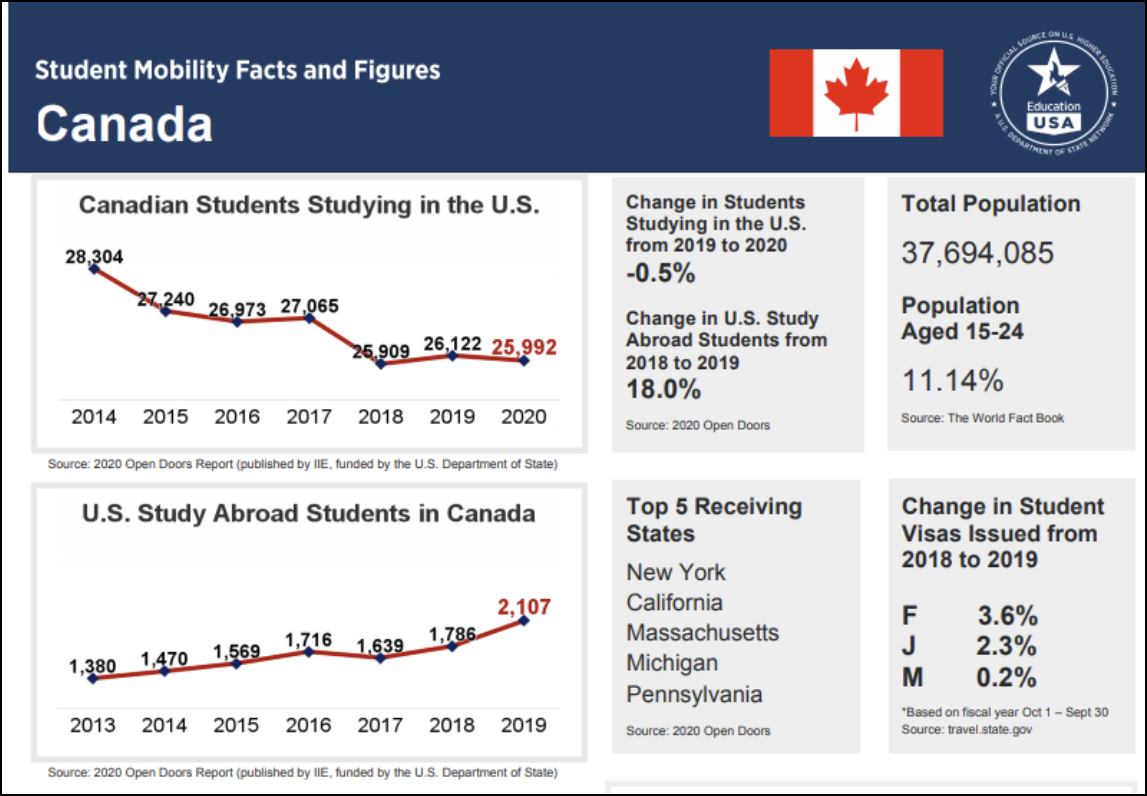Capital: Ottawa
Population: 37,694,085 (July 2020 est.)
GDP: 1.774 Trillion USD (2017 est., Purchasing Power Parity)
Currency: Canadian Dollars (CAD)
Language: English, French (official)
UNESCO Student Mobility Number:
Canada has 48,345 students studying abroad according to UNESCO.
CIA World Factbook:
27.13% of the Canadian population is under 24 years old.
OVERVIEW
In Canada, education falls separately under the responsibility of the country’s ten provinces and three territories. Each province and territory is controlled by a department or Ministry of Education and led by a Minister of Education. The education ministers are responsible for planning, finance, curriculum development, and assessment of knowledge, as well as serve on the Council of Minister of Education Canada (CMEC). CMEC is an intergovernmental body of ministers of education established to do the following: discuss policy issues, undertake activities, projects, initiatives in areas of mutual interest, consult and cooperate with national education organizations, as well as the federal government, and represent the education interests of the provinces and territories internationally.
Post-secondary education is funded through a combination of public sources including funds allocated by the provincial governments, educational institutions, and other sources like corporate donations, increased tuition, or specialized fee programs. A large portion of university funding also derives from the enrollment of international students in Canada.
There are several options to obtain a post-secondary education in Canada originating from universities, colleges, polytechnics, CEGEP (a mandatory one-year program in Quebec before students enroll in post-secondary education), apprenticeships, and some large private vocational institutions. Schools operating in Canada must be registered and need to follow strict curriculum and graduation requirements. Few U.S. institutions operate in Canada however those that do include the New York Institute of Technology and Farleigh Dickinson University, operating campuses out of Vancouver, and Northeastern University operating in Toronto.
As of 2020, and despite the global COVID-19 pandemic, Canada kept its ranking this year as the fifth largest source of international students with 25,992 enrolled in higher education institutions in the United States for the year 2019/20, a small decrease from 26,122 in 2018/19. U.S. study abroad students in Canada increased from 1,786 to 2,107 for the same period.
SUB-SECTORS
Higher Education
Higher education remains a competitive service export sector in the bilateral trade relationship with 25,992 Canadian students having attended U.S. schools in the 2019-20 academic year according to IIE’s Open Doors report. Cost remains one of the main barriers for student mobility for Canadians and the great majority will opt to stay in their family home while attending university.
Undergraduate
In the 2019/20 school year, 12,409 students from Canada were enrolled in undergraduate courses, 1% less than in 2018/19. During the 2019/20 school year, business management and health professions were the most popular fields of study for Canadian students.
Graduate
The percentage of graduate students attending U.S. institutions in 2019/20 increased by 0.2% when compared to 2018/19.
Non-degree
Nearly 2.1% of Canadian students in the U.S. attend non-degree programs (also known as “short term programs” or “non-credit programs”) during 2019/20, representing a 7.3% decrease from the previous year.
Optional Practical Training (OPT)
The number of Canadian students pursuing OPT options in the United States decreased by 1.2% in 2019/20, as despite OPT’s popularity, border closures and uncertainty with regards to COVID-19 pushed down an otherwise increasingly popular option.
OPPORTUNITIES
The discussions resulting in the signature of the Council of the Great Lakes Region consortium in November 2020 provides a stepping stone to leveraging deeper collaboration among cross-border institutions in 8 U.S. States and 2 Canadian provinces, resulting in improved educational curricula and a better equipped work force for the region.
U.S. academic institutions can explore exchange programs and partnerships with Canadian educational institutions, some of which can include cross-border tuition agreements, reciprocity programs, or in-state tuition for Canadian students. Athletic scholarships are very popular options that attract Canadian students to the United States. Important opportunities exist in student recruitment for highly specialized programs or “niche” studies that may not be available in Canadian institutions.
Engaging with Canadian schools in key subjects around climate change, sustainability, and Artificial Intelligence (AI) will be key to leveraging opportunities and increasing student mobility in the years ahead.
Post-pandemic student enrollment is expected to pick back up as 40% of students have deferred their enrollment to a future term. Focusing on Optional Practical Training opportunities to facilitate hands-on experience for the students as well as focusing on CEGEPs and English Language programs for francophone students are also expected to be important pathways to increase Canadian enrolment in U.S. institutions.
EVENTS
- Options Career Fair
RESOURCES
- U.S. Commercial Service – Canada: https://www.trade.gov/canada
- U.S. & Foreign Commercial Service Global Education Team: www.trade.gov/education-industry
- Industry and Analysis, Office of Supply Chain, Professional & Business Services: https://www.trade.gov/professional-and-business-services
- UNESCO student Mobility number: http://uis.unesco.org/en/uis-student-flow
- CIA World Factbook: www.cia.gov/library/publications/the-world-factbook/geos/ca.html
- Universities Canada: www.univcan.ca
- Council of Ministers of Education: www.cmec.ca
- Fulbright Canada: http://www.fulbright.ca/
- Institute of International Education – Open Doors: www.iie.org
- EducationUSA Canada https://www.educationusacanada.ca/
- Canadian Information Centre for International Credentials (CICIC): www.cicic.ca/976/get_information_on_applying_to_study_abroad.canada
U.S. COMMERCIAL SERVICE CONTACT
Ozlem Toplu, Commercial Specialist
U.S. Commercial Service – Toronto, Canada
